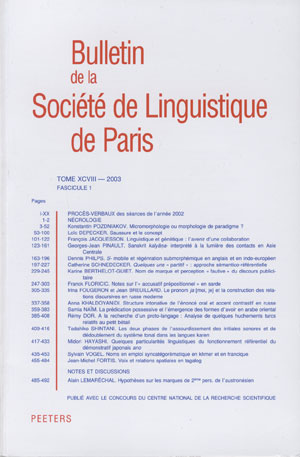 previous article in this issue previous article in this issue |

Preview first page |
Document Details : Title: Variations étymologiques sur l'étymon sino-tibétain 'étau, pinces' Author(s): YUNFAN, Lai Journal: Bulletin de la Société de Linguistique de Paris Volume: 117 Issue: 1 Date: 2022 Pages: 297-312 DOI: 10.2143/BSL.117.1.3291567 Abstract : La racine originellement signifiant ‘étau, pinces’, se retrouve dans beaucoup de langues sino-tibétaines à travers l’Himalaya avec différents sens, y compris ‘dent/molaire’, ‘mâchoire’, ‘mâcher’ et ‘vulve, vagin’, outre la signification d’origine. Cet article analyse les changements sémantiques d’un point de vue linguistique historique, en se concentrant sur les réflexes en birmo-rgyalronguique, tibétain et chinois. Les autres langues où l’étymon est attesté sont aussi discutées. À la fin de l’article, on traite du cas unique trouvé en choyul, où l’étymon donne le sens de ‘vulve, vagin’, en proposant une hypothèse que ce changement sémantique provient d’une histoire empruntée récemment dans la région rgyalronguique, Vagina dentata. The word originally meaning ‘pincers, pliers’, is found in many Sino-Tibetan languages across the Himalayas with different meanings, including ‘tooth/molar tooth’, ‘jaw’, ‘chew’ and ‘vulva, vagina’, besides the original meaning. This article analyses semantic changes from a historical linguistic point of view, focusing on reflexes in Burmo-Rgyalrongic, Tibetan and Chinese. The other languages where the etymon is attested are also discussed. At the end of the article, we deal with the unique case found in Choyul, where the etymon gives the meaning of ‘vulva, vagina’, proposing a hypothesis that this semantic change comes from a recently borrowed story in the Rgyalrongic region, Vagina dentata. |
|


